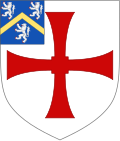History
Founded in 1960 to support the university's teaching and research in the School of Oriental Studies, the collections of the museum have largely grown through donations and purchases to support cultural studies alongside the teaching of languages, particularly following the appointment of William Thacker as Professor of Hebrew and Oriental Languages in 1941 and the establishment of the School of Oriental Studies in 1951. The museum had its beginnings in Thacker's acquisition in 1949 of the Northumberland Collection of items from Egypt and the Near East. The collection was initially housed in two rooms (one for display, one for storage) in Hatfield College, with viewing by appointment only. After this was forced to close in 1956, the collection was placed in storage. [5]
In 1953, as part of the celebrations of the Coronation of Elizabeth II, Raymond Dawson, lecturer in Chinese, curated an exhibition of loaned Chinese bronzes. In 1954, Cosin's Library hosted an exhibition of Chinese books and textiles. These led to major donations to the university of the Chinese ceramics collection of Malcolm MacDonald and the jades and hardstones collections of Charles Hardinge in the late 1950s. [5] [6]
The growth of the school led to it moving to Elvet Hill House, the current location of the museum, on the south edge of Durham. With part of the collection still held at various sites and the success of the initial exhibitions, potential donors were sought for the formal establishment of a museum. A successful bid was made to the Gulbenkian Foundation in 1957 with a £60,000 donation to fund the initial stage of the museum, which was named the "Gulbenkian Museum of Oriental Art and Archaeology". The museum was completed in 1959 with the collections being transferred to the new museum by the end of the year. After the creation of the displays, the museum was officially opened in May 1960 with a three-day week initially attracting c.100 visitors a week. [7]
In October 1969 a fragment of Moon rock was sent to the university's department of earth sciences. Prior to undergoing analysis the rock was displayed at the museum for two days attracting over 12,000 people resulting in the museum opening until 8:30pm to accommodate the visitors. [7]
In the 1980s the name was shortened to the "Oriental Museum" and there were plans for a major rebuilding and refurbishment, which was not carried out. [6]
In 2008, the Ancient Egyptian and Chinese collections were granted designated status as collections of national and international importance by the Museums, Libraries and Archives Council. [8]
In 2012, thieves stole Chinese artefacts worth almost £2 million. The items were recovered by police and returned to the museum. [9] In 2013, two men were found guilty of the theft and jailed. [10]
In 2013, the museum received funding from the Arts Council for the redevelopment of the South Asian and Himalayan collections, including creation of a new gallery, as part of a four-year refurbishment of all of the galleries. [11] In 2000 funding was secured from the National Lottery to create a mezzanine floor to display additional artifacts from the collections. [6]
A new Egyptian gallery, named the Thacker gallery after the school of oriental studies' first director, was opened in 2016 following a refurbishment of the museum. It included an Egyptian mummy known as "The Lady", who was buried around 300 BC with the oldest-known prosthetic limb, made of linen and plaster, as well as a six-inch figurine of a serving girl carrying a jar from 1360 BC, part of a short period when Egyptian artists made life-like pieces. [12]
In 2016, the museum began a partnership with China's Palace Museum. In 2025, it became the only institution outside of China to host the "Journey of a Century: From the Forbidden City to the Palace Museum" photographic exhibition celebrating 100 years of the Palace Museum. [13]
In 2017, the museum staged the first exhibition held in Britain on the Chinese Labour Corps volunteers who assisted the British Army in World War I. [14]
In 2021, the museum returned two Japanese Good Luck Flags that were taken as souvenirs in World War II to the families of their owners. One flag had been part of the university's collection for many years but was only identified in 2018, while the other was temporarily held by the museum at the request of the police while the work to return it was carried out. [15]
The museum held an exhibition in 2024 on the 1924 British Mount Everest expedition, featuring an internationally important collection of photographs taken by Bentley Beetham, one of the survivors of the exhibition. [16]
In 2025, the museum returned an 18th century Māori war cloak (pauku) with a rare Tāniko border to New Zealand on a five-year loan to the Auckland War Memorial Museum. The cloak, one of only five known to exist, was loaned to the Durham museum in the 1960s before being gifted in 1971, and is the first to return to New Zealand. Rangi Te Kanawa and other Māori experts worked from 2017 with staff from the museum and Durham's archaeology department to research and conserve the cloak. Further research will be carried out during the loan to find out more about the origins of the cloak and to determine the most appropriate permanent location. [17] [18]

